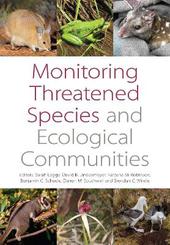
|
Monitoring Threatened Species and Ecological Communities
Paperback / softback
Main Details
Description
Monitoring is integral to all aspects of policy and management for threatened biodiversity. It is fundamental to assessing the conservation status and trends of listed species and ecological communities. Monitoring data can be used to diagnose the causes of decline, to measure management effectiveness, and to report on investment. It is also a valuable public engagement tool. Yet in Australia, monitoring threatened biodiversity is not always managed optimally. Monitoring Threatened Species and Ecological Communities aims to improve the standard of monitoring for Australia's threatened biodiversity. It gathers insights from some of the most experienced managers and scientists involved with monitoring programs for threatened species and ecological communities in Australia, and evaluates current monitoring programs, establishing a baseline against which the quality of future monitoring activity can be managed. Case studies provide examples of practical pathways to improve the quality of biodiversity monitoring, and guidelines to improve future programs are proposed. This book will benefit scientists, conservation managers, policy makers, and those with an interest in threatened species monitoring and management.
Author Biography
Sarah M. Legge is an Honorary Professor at The Australian National University, and a Professorial Fellow at Charles Darwin University. Sarah is a wildlife ecologist with 30 years of research and conservation management experience. She is a co-author of Cats in Australia and co-editor of Monitoring Threatened Species and Ecological Communities. Professor David B. Lindenmayer AO has worked as a researcher on Australian farms for more than 23 years. He has a particular interest in improving environmental conditions on farm properties, including protecting remnant native vegetation as well as restoring and replanting it. He specializes in establishing and maintaining ecological large-scale, long-term research and monitoring programs on farms. He has co-authored a number of other books, including Natural Asset Farming and Restoring Farm Woodlands for Wildlife. Natasha Robinson performs research on threatened species monitoring and management, mammal re-introductions and fire ecology. She works closely with partner management agencies to ensure that her research improves on-ground management outcomes. Previously, she worked for the Victorian State Government in ecological fire management and biodiversity conservation, and in northern rural Vietnam developing sustainable livelihood projects that had cultural, conservation and socio-economic benefits. She completed her PhD on the importance of refuges for birds in the severely burnt forest of central Victoria. Benjamin Scheele is an ecologist with a particular interest in threatened species management and recovery. He has researched threatened species across diverse landscapes ranging from the Australian Alps to the ancient farming landscapes of Transylvania. Ben's research has strong links to management and his work on threatened amphibians has informed the development of innovative applied management responses. Darren Southwell is an ecologist with an interest in optimal monitoring, adaptive management and population viability analysis. His PhD developed population models for threatened and invasive species to inform cost-effective management decisions. Previously, he worked as a quantitative scientist at the Department of Agriculture, Fisheries and Forestry and as a field biologist at the Australian Antarctic Division. Brendan A. Wintle is a Professor in Conservation Ecology and a Principal Investigator in the Quantitative and Applied Ecology group (QAECO) at The University of Melbourne. He is passionate about the conservation of Australia's unique flora and fauna. He is a co-editor of Monitoring Threatened Species and Ecological Communities.
|